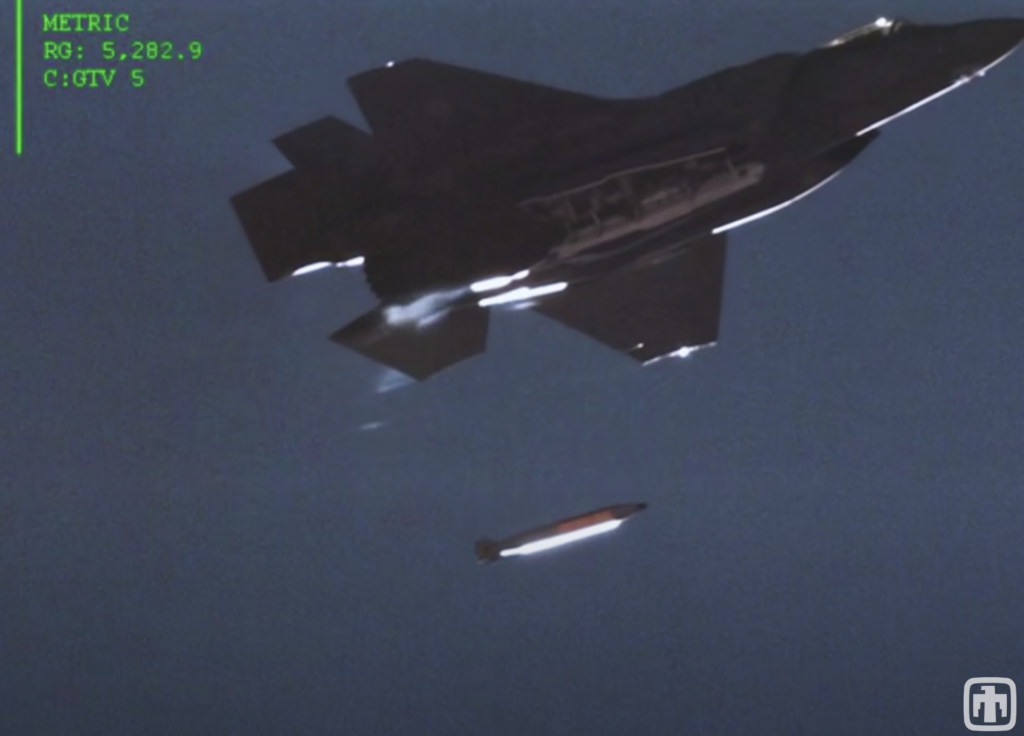Why the Biden administration’s new nuclear gravity bomb is tragic
By Stephen Young | February 13, 2024
 A US F-35A combat aircraft tests an unarmed B61-12 bomb in the Nevada Desert. Source: Sandia National Laboratory
A US F-35A combat aircraft tests an unarmed B61-12 bomb in the Nevada Desert. Source: Sandia National Laboratory
In late October 2023, the Pentagon announced—to the surprise of many, including congressional staffers who work on these issues—that it was pursuing a new nuclear weapon to be known as the B61-13, a gravity bomb.
This is a troubling development for many reasons. First, it is merely the latest in a long line of new nuclear weapons that the United States is building or proposing, in yet another sign that a new nuclear arms race is expanding. In addition, it breaks a promise the Obama administration made to eliminate almost all types of US nuclear gravity bombs, while further undermining President Biden’s pledge to reduce the role of nuclear weapons in US security. Most tragically, it further cements an absolute commitment on the part of the United States to retain nuclear deterrence as the centerpiece of its security policy for decades to come. While most of us hope the world can eventually stop relying on the threat of mass murder at a global scale as the basis for international security, the B61-13 moves everyone further away from that day.
Starting from the top, here is the entire, vast set of new nuclear bombs and warheads the United States recently developed or is pursuing:
- The Trump administration’s new “low-yield” warhead, deployed on sea-launched ballistic missiles (SLBMs) carried by US submarines, with an estimated explosive yield roughly one-third the size of the gravity bomb dropped on Hiroshima. “Low-yield” is a relative term; this warhead could still kill tens of thousands in an instant.
- The new, more lethal B61-12 gravity bomb that the National Nuclear Security Administration (NNSA) recently started producing, after many years of delay (and with each bomb costing more than its weight in gold).
- The updated warhead for the stealthy air-launched cruise missile first proposed by the Obama administration, ideally suited to start a nuclear war.
- A variant of that cruise missile warhead for a sea-launched cruise missile that a) the Trump administration proposed, b) the Biden administration is trying to cancel, but c) Congress recently required the administration to pursue.
- The precedent-setting warhead for land-based missiles that, for the first time since the end of the Cold War, will be made entirely from new components, with nothing being reused except the basic design of the warhead.
- The momentous new warhead for submarine-launched ballistic missiles, the first entirely new bomb since the end of the Cold War, with both the components and the design of the weapon made anew.
- The B61-13.
All these new bombs and warheads are just part of a massive rebuilding of the entire US nuclear arsenal, which also includes new long-range, land-based missiles, new submarines, new stealthy, long-range bombers that will carry the new stealthy cruise missiles mentioned above, and major upgrades to the missiles carried by the submarines. The total cost to do all that while maintaining the existing weapons will be well over $1.2 trillion during the next 25 years.
In short, a new nuclear arms race is exploding across the globe, and while the Biden administration has not announced plans to increase the size of its nuclear arsenal (despite bipartisan pressure to do so), it is racing to climb what is often called a “modernization mountain”—a journey that will certainly take longer and cost far more than currently projected, all to produce a vastly oversized nuclear stockpile that everyone hopes will never be used.
The broken promise. There is a second and compounding problem with the B61-13: It breaks a promise made during the Obama administration to eliminate all but one of the types of US gravity bombs. Specifically, to win support for the B61-12—a new guided gravity bomb the Pentagon and NNSA badly wanted—the Obama administration proposed to retire the B61-3, B61-4, B61-7, B61-10, B61-11, and the B83 gravity bombs, trading six weapons for one. Unfortunately, since its inception the B61-12 has faced major cost overruns and years of delays. The NNSA initially said the bomb would cost $4 billion, then quickly raised the tab to $8 billion, while the Pentagon initially estimated it at $10 billion. The actual cost, including work the Air Force is doing, will be as much as $14 billion. The NNSA initially projected it would begin making the bombs in 2017, while the Pentagon said it would be 2022 before work started. The Pentagon was right, with the B61-12 finally entering production late in 2022.
On top of all the cost increases and delays, the associated commitment to retire the six other gravity bombs is changing significantly.
First, it is not clear the B61-11 will be retired at all; planning documents no longer include it as something the B61-12 will replace. That variant is designed to penetrate into the Earth, to attack hardened and deeply buried targets. No administration has ever explained why it was removed from the retirement list; it simply stopped being included on it. Second, the sole bright spot is the B61-10, but oddly so. Although the bomb’s retirement was tied to starting production of the B61-12, the B61-10 was removed from the stockpile in 2016. Apparently, it really was not needed at all, regardless of the B61-12.
More dangerously, the decision to retire the B83—by far the most destructive weapon in the US nuclear stockpile—was reversed by the Trump administration. The B83 has an explosive yield of some 1.2 megatons—or 80 times larger than the bomb dropped on Hiroshima. In a simulation developed by the Union of Concerned Scientists (UCS, where I work), dropping one bomb like the B83 on a nuclear facility in Iran would kill over three million people and spread deadly radiation across Afghanistan, Pakistan, and India. It is this behemoth that the Trump administration declared its intention to keep “until a suitable replacement is identified.” Fortunately, the Biden administration reversed the reversal, and the B83 is currently on a path to be retired at some point, though the plan for when that will happen is classified. (Unfortunately, election results this year could again change that outcome.)
In the meantime, the Biden administration has announced the B61-13.
Significantly, this new bomb will be based on the B61-7, the most destructive of the B61 variants, with a maximum yield of 360 kilotons, or 24 times more devastating than the bomb dropped on Hiroshima. Just to remind you, that one bomb killed 70,000 to 140,000 people. In other words, the B61-13 will be massively destructive, accompanied by immense and widespread fallout. In other other words, this is yet another tool for nuclear warfighting—or, more specifically, seeking to win a nuclear war.
That mission should not exist. Indeed, as five of the countries with nuclear weapons—the United States, Russia, China, France and the United Kingdom—have declared, “a nuclear war cannot be won and must never be fought.”
Yet fighting and winning a nuclear war is precisely the goal of developing the B61-13. There are, apparently, specific targets that this more powerful gravity bomb can hold at risk—ones that cannot reliably be destroyed with the B61-12, despite its vastly increased accuracy in comparison to existing gravity bombs. But existing nuclear warheads on submarine-based missiles can already hold those same targets at risk. So the B61-13, it turns out, is just another option to blow up something the Pentagon can already destroy, and many times over. In fact, each US nuclear-armed submarine carries seven times the destructive power of all the bombs dropped during World War II, including the two atomic bombs dropped on Japan.
The scope of the mistake. Coming from a Biden administration that pledged to seek to reduce the role of nuclear weapons, with a president who, as a candidate for office, declared his support for the policy that the United States would never use nuclear weapons first in any conflict, the decision to pursue the B61-13 is not only deeply disappointing, but a profound mistake. In short, the B61-13 is yet another sign that the United States intends to make its nuclear arsenal even more deadly and the foundational element of the existing security system. That system is based on the principle that this country, to keep itself “safe,” needs to be able to kill tens or hundreds of millions of people in less than an hour.
On moral grounds, and under international law, that prospect alone should be evidence enough to conclude that such an approach to security is grievously wrong, and that the United States should do everything it can to move away from that system.
But the reality is far worse, because Russia already has and China is now moving toward nuclear arsenals that will give them similar capabilities. Even with their vastly smaller arsenals, the other six nuclear weapons states—the UK, France, India, Pakistan, Israel, and North Korea—also have the capacity to kill tens of millions of people in hours. That horrible reality is the basis of the world’s security system. If everyone can kill everyone else, and no one can be safe from that threat, then—in the supreme irony of nuclear deterrence—everyone is supposed to be safe.
The mutual assured destruction precept of deterrence theory is ludicrous. For such a system to make sense, it would have to work perfectly and for all time. If it doesn’t, then we are all dead.What human system has ever worked perfectly for any significant length of time? In just one example of far too many, nuclear war was barely averted when a Russian officer refused to go along with two colleagues who wanted to use a nuclear-armed torpedo against US Navy ships harassing their submarine at the height of the Cuban Missile Crisis. As has been noted, it was as much luck as careful choices that avoided the start of a nuclear war that would almost certainly have spiraled out of control.
Rather than develop a new nuclear weapon that adds fuel to a rapidly growing arms race, the Biden administration should launch a concerted effort to rid the world of nuclear weapons. It should publicly announce this intention, invite representatives from other nuclear-armed states to the table, and begin talks about what would be required to eliminate nuclear weapons from Earth. In an ideal world, we could turn the tragedy of the B61-13 into the launching point for a global effort to push for that outcome.
Together, we make the world safer.
The Bulletin elevates expert voices above the noise. But as an independent nonprofit organization, our operations depend on the support of readers like you. Help us continue to deliver quality journalism that holds leaders accountable. Your support of our work at any level is important. In return, we promise our coverage will be understandable, influential, vigilant, solution-oriented, and fair-minded. Together we can make a difference.
Keywords: B61-13, NNSA, arms race, nuclear bombs
Topics: Analysis, Nuclear Weapons
















A concerted effort to abolish nuclear weapons will always fail because of Russia. Moscow absolutely depends on nuclear weapons for its security doctrine. A conventionally exceptionally weak Russia cannot afford to give up on nukes. China will see it likewise. To demand a nuclear disarmament under these circumstances is ludicrous in itself.
Correction+: Hiroshima: about 70,000 dead within about 24 hours; about 140,000 dead by Dec. 31, 1945.
Nagasaki: about 73,884 dead by Dec. 31, 1945, this estimate by Sumiteru Taniguchi of Nagasaki.
Thus total, about 210,000+ by Dec. 31, 1945,
and the counting could not stop then.
The use of nuclear power to mitigate anthropomorphic CO2 production may pose as great a long term danger as the proposed upgrade of nuclear bomb arsenal. First of all, construction time and energy costs of building nuclear power plants makes them impractical, given the narrow window left to avoid catastrophic climate change. Secondly, as seen in Ukraine, cultures are unstable and collapse suddenly, and the very last thing that they will do is give up their energy resources. In other words, very few of the current 450 nuclear power plants will end in cold storage, which takes 60 years to accomplish.… Read more »
I hear a whole lot about talk of peace and nuclear disarmament from you but I’ve yet to hear your plan to supplant these weapons. Pray tell what do you propose would take the place of these weapons while maintaining the same level of deterrence? This talk of morals and peace is wonderful on paper, unfortunately we live in the real world where dictators and despots are pervasive. Hence the need for the deterrence.